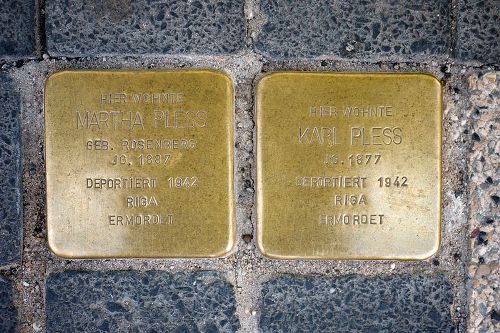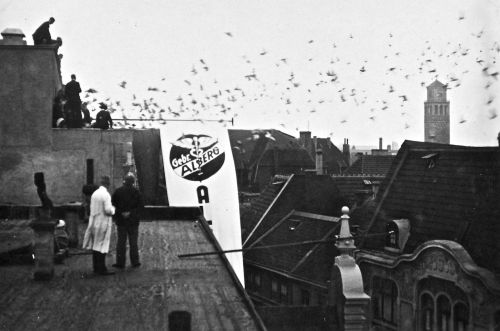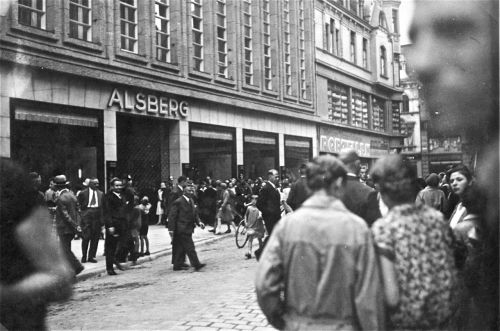Stumbling Stones Viktoriastraße 26-28
These memorial stones (so called Stolpersteine of stumbling blocks) commemorate:
Martha Pless (born 1887, murdered in Riga)
Karl Pless (born 1877, murdered in Riga)
Karl and Martha Pless
Karl Pless was born on 11 March 1877 in Stargard, Pomerania. He received a business education. After initially settling in Ruhrort, Duisburg, he later moved to Mülheim an der Ruhr in 1902.
In January 1907, Karl Pless married Martha Rosenberg (b. 15 July 1887), from Dortmund, Westphalia.
Their eldest son, Herbert, was born in 1909, followed in 1913 by twins, Walter and Ernst. The family first lived in Friedrichstrasse and later at Victoria Street 26, on Victoria Platz in front of the Mülheim Synagogue and main post office.
Gebrüder Alsberg (Mülheim-Ruhr)
Karl Pless, began his textile business, Gebrüder Alsberg (Mülheim-Ruhr), in 1905. It was situated on Bachstrasse 36-38 (today, Leineweberstrasse). As sole proprietor, he obtained the rights to the name, ''Alsberg'', on the recommendation of his brother Franz Pless, who already had such a store in Duisberg-Ruhrort. They were subsidiaries of the group Fried & Alsberg whose headquarters were in Cologne.
The success of the business led to the acquisition and consolidation of several parcels of land adjacent to and behind the old building. A new modern five-storey building was built in 1927/28, designed by architect, Grossman, who also built the Mülheim Stadthalle. Karl''s son, Herbert, had a hand in the design of the new Gebr. Alsberg façade, which still exists to this day.
The ''kaufhaus'' sold all kinds of textiles: ladies'' clothing, men''s shirts, headwear and furnishing materials with departments for perfume and dry cleaning, too. On the first floor was a large "Konditorei" (café with patisserie) where live music was performed to entertain the customers. It was the second biggest store in Mülheim by 1933, with two hundred employees.
Nazi Period
With the rise to power of the NSDAP in 1933, 6 months of boycotts and the prevention of entry of customers by uniformed ''Brown Shirts'', Karl Pless was forced to transfer ownership to Aryan owners, Berger & Lindner, in October 1933.
Having no visa for a foreign country, nor an affidavit for the United States, Karl and Martha moved to Berlin to try and create a new life for themselves. Karl established a new business, Pless & Löwenthal, manufacturing lingerie before he was commandeered to work in a Nazi munitions factory.
Emigration
One by one, the children of the Pless family emigrated with the advent of National Socialism. The eldest son Herbert, having completed his German legal education and training, was barred from practicing law because of his Jewish origins. In 1933, he fled to France.
Walter Pless, after doing his apprenticeship both in Düsseldorf and Berlin from 1930 onwards, joined his father in 1935 to help build up the new Berlin lingerie business. He immigrated to South Africa in 1936.
Twin brother Ernst decided to immigrate to Palestine and in preparation attended an agricultural training centre in Mecklenburg. In 1938 he received the necessary papers and left Germany for Palestine.
Deportation
After Kristallnacht in November 1938, Karl and Martha booked to join their son, Ernst in Palestine. But with the outbreak of World War II in 1939, they were prevented from leaving. The tragic irony is that the lift with their furniture arrived in Palestine but not them.
Martha and Karl Pless were deported to Riga on 13 January 1942 where they eventually perished. (according to Nazi records). Indications in some records suggest that they may have been sent to Theresienstadt before Riga.
Their three sons survived the Holocaust in exile.
The small copper plaques, in the pavement in front of houses of which the (mostly Jewish) residents were murdered by the Nazis, mention the name, date of birth and place (mostly a concentration camp) and date of death.
In many other cities, mainly in Germany but also in other European countries, the memorials also can be found. There are already many thousands of these plaques and their number is still counting. Almost all Stolpersteine are laid by the German artist himself, Gunter Demnig.
For more information and pictures, please visit Stolpersteine Mülheim an der Ruhr (in German).
Do you have more information about this location? Inform us!
Source
- Text: Fedor de Vries & Norman Pless, grandson of Karl and Martha Pless, son of Walter Pless.
- Photos: Ralf Hülz and Norman Pless (Gebrüder Alsberg 1928)
Nearby
Museum
Point of interest
Monument
- War Memorial Mülheim an der Ruhr - Mülheim an der Ruhr
- War Memorial Wasserrinne - Mülheim an der Ruhr
- Bismarck-tower Mülheim an der Ruhr - Mülheim an der Ruhr
Cemetery
- German War Cemetery Uhlenhorst - Mülheim an der Ruhr
- Kaiserberg German War Cemetery - Duisburg
- German War Graves Essen-Fulerum - Essen-Fulerum








